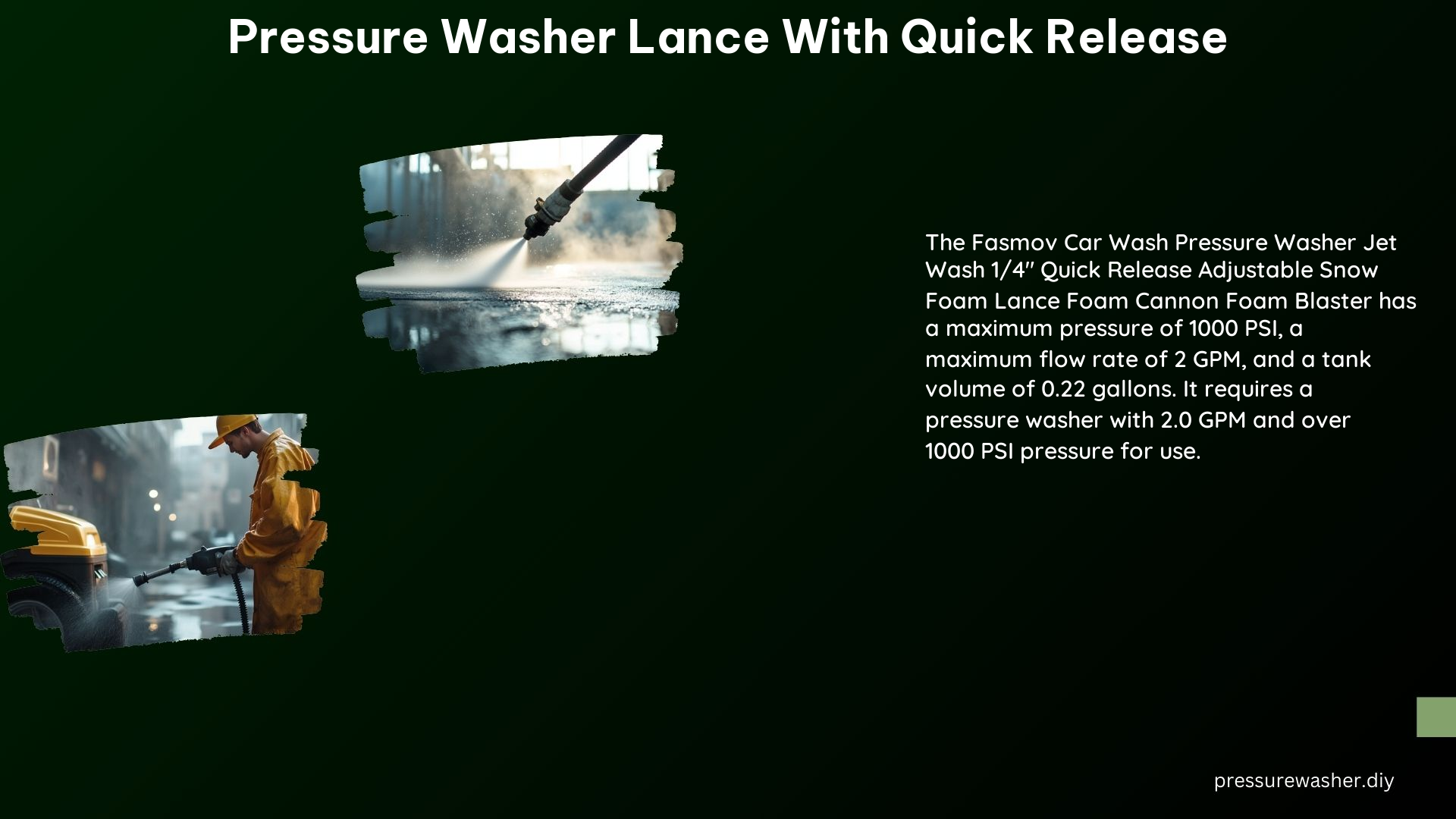A pressure washer lance with a quick release is a versatile and convenient tool for various cleaning tasks, allowing users to quickly and easily switch between different nozzles or attachments. This comprehensive guide will delve into the technical specifications, common issues, and DIY tips and tricks to help you get the most out of your pressure washer lance with a quick-release mechanism.
Can I Use a Pressure Washer Lance with a Quick Release Without a Quick-Release Connector on My Pressure Washer?
Yes, you can use a pressure washer lance with a quick release without a quick-release connector on your pressure washer. However, you will need to ensure that the lance is compatible with your pressure washer’s hose and fittings. Some lances come with adapters that can be used to connect to different types of pressure washers, such as Karcher, Nilfisk, or Kranzle. These adapters typically feature a male or female quick-connect fitting that can be attached to the pressure washer’s hose or wand.
It’s important to note that using a pressure washer lance with a quick release without a compatible quick-release connector may result in leaks or reduced performance. Always check the manufacturer’s recommendations and ensure a secure, leak-free connection before operating your pressure washer.
How Do I Fix a Stuck Quick-Connect on My Pressure Washer Lance?

To fix a stuck quick-connect on your pressure washer lance, follow these steps:
-
Clean the connector: Make sure the connector is free from dirt, debris, and any buildup of dried cleaning solutions or chemicals. Use a soft brush or cloth to gently clean the connector, taking care not to scratch or damage the surface.
-
Apply lubricant: Apply a small amount of a silicone-based lubricant or grease to the connector. This can help loosen any stuck parts and prevent future issues. Avoid using petroleum-based lubricants, as they may damage the seals or O-rings in the connector.
-
Use a wrench or pliers: If the connector is still stuck, use a wrench or pliers to gently loosen it. Apply a small amount of force, being careful not to apply too much pressure, as this could damage the connector.
-
Check for blockages: Ensure there are no blockages or kinks in the hose that could be causing the connector to stick. Inspect the hose for any obstructions or damage that may be preventing a smooth connection.
-
Soak in a cleaning solution: If the above steps do not work, you can try soaking the stuck connector in a mild cleaning solution, such as a mixture of water and white vinegar or a dedicated quick-connect cleaner. Allow the connector to soak for a few minutes before attempting to loosen it again.
Remember, it’s essential to handle the quick-connect with care to avoid damaging the mechanism. If the connector remains stuck or you are unable to resolve the issue, it may be necessary to replace the entire pressure washer lance or the quick-connect component.
What Are Some Common Issues with Pressure Washer Lances That Have Quick-Release Mechanisms?
Some common issues with pressure washer lances that have quick-release mechanisms include:
-
Stuck connectors: As mentioned earlier, stuck connectors can be a frustrating problem. Regular cleaning, lubrication, and proper handling can help prevent this issue.
-
Leaking connections: Leaks can occur if the connections are not properly secured or if the O-rings or seals are damaged. Inspect the connections regularly and replace any worn or damaged components to maintain a tight, leak-free seal.
-
Damage to the lance: The pressure washer lance itself can be damaged if it is not handled with care. Avoid bending, kinking, or dropping the lance, as this can compromise the structural integrity and performance of the quick-release mechanism.
-
Compatibility issues: Ensure that the pressure washer lance with a quick release is compatible with your specific pressure washer model and its hose and fittings. Using an incompatible lance can lead to connection problems, leaks, or even damage to the pressure washer.
-
Wear and tear: Over time, the components of the quick-release mechanism, such as the O-rings, springs, and locking mechanisms, may wear down and require replacement. Regular inspection and maintenance can help prolong the lifespan of your pressure washer lance.
To address these common issues, it’s essential to follow the manufacturer’s instructions for proper use, maintenance, and storage of your pressure washer lance with a quick-release mechanism.
Technical Specifications of Pressure Washer Lances with Quick Release
When selecting a pressure washer lance with a quick release, consider the following technical specifications:
Material:
– Stainless steel: Offers excellent durability, corrosion resistance, and longevity, making it a popular choice for pressure washer lances.
– Brass: Provides a balance of strength, corrosion resistance, and affordability, making it a suitable option for many pressure washer applications.
– Aluminum: Lightweight and corrosion-resistant, but may not be as durable as stainless steel or brass under high-pressure conditions.
Pressure Rating:
– Typical pressure ratings range from 1,000 to 5,000 PSI (pounds per square inch), with higher-end models capable of handling up to 7,000 PSI.
– Ensure the lance is rated for the maximum pressure of your pressure washer to prevent damage or unsafe operation.
Flow Rate:
– The flow rate of the lance should match the flow rate of your pressure washer, typically ranging from 2 to 10 GPM (gallons per minute).
– Using a lance with an incompatible flow rate can result in reduced cleaning performance or even damage to the pressure washer.
Connection Type:
– Choose a lance with a quick-release connection that is compatible with your pressure washer’s hose and fittings, such as a M22, M14, or other standard quick-connect type.
– Some lances come with universal adapters to accommodate different pressure washer models.
Length and Flexibility:
– Pressure washer lances are available in various lengths, typically ranging from 12 to 36 inches.
– Consider a lance with a flexible or adjustable length to reach hard-to-access areas or maneuver around tight spaces.
Nozzle Options:
– Many pressure washer lances with quick releases come with interchangeable nozzle tips, allowing you to adjust the spray pattern and intensity for different cleaning tasks.
– Common nozzle types include 0°, 15°, 25°, and 40° spray patterns, as well as rotary and turbo nozzles.
By carefully considering these technical specifications, you can select a pressure washer lance with a quick release that is well-suited for your specific cleaning needs and pressure washer capabilities.
DIY Tips and Tricks
To get the most out of your pressure washer lance with a quick release, consider the following DIY tips and tricks:
- Regular Maintenance:
- Regularly clean and inspect the quick-release connections, O-rings, and other components to ensure they are in good working condition.
- Apply a small amount of silicone-based lubricant or grease to the quick-release mechanism to prevent sticking and maintain smooth operation.
-
Store the lance properly when not in use to prevent damage or contamination.
-
Nozzle Selection:
- Choose the appropriate nozzle for the cleaning task at hand, considering the surface material, level of soiling, and desired spray pattern.
- Experiment with different nozzle types and angles to find the most effective and efficient cleaning solution.
-
Regularly inspect and clean the nozzle tips to maintain optimal performance.
-
Proper Handling:
- Avoid bending, kinking, or dropping the pressure washer lance, as this can damage the quick-release mechanism and the lance itself.
- When not in use, store the lance in a safe, secure location to prevent accidental damage.
-
Be cautious when using the lance, as the high-pressure water stream can cause injury if not handled properly.
-
Accessory Compatibility:
- Explore compatible accessories, such as extension wands, rotating brushes, or surface cleaners, that can be quickly attached to the pressure washer lance.
-
These accessories can expand the versatility of your pressure washer and enhance your cleaning capabilities.
-
Troubleshooting:
- If you encounter any issues with your pressure washer lance, such as leaks, stuck connections, or reduced performance, refer to the manufacturer’s troubleshooting guide or seek professional assistance if necessary.
- Attempting to disassemble or repair the lance without proper knowledge and tools can lead to further damage.
By following these DIY tips and tricks, you can ensure the longevity and optimal performance of your pressure washer lance with a quick-release mechanism, making your cleaning tasks more efficient and effective.
